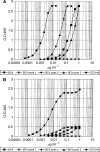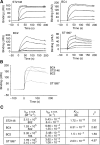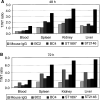Novel antitenascin antibody with increased tumour localisation for Pretargeted Antibody-Guided RadioImmunoTherapy (PAGRIT)
- PMID: 12671694
- PMCID: PMC2376359
- DOI: 10.1038/sj.bjc.6600818
Novel antitenascin antibody with increased tumour localisation for Pretargeted Antibody-Guided RadioImmunoTherapy (PAGRIT)
Abstract
The Pretargeted Antibody-Guided RadioImmunoTherapy (PAGRIT) method is based on intravenous, sequential administration of a biotinylated antibody, avidin/streptavidin and (90)Y-labelled biotin. The hybridoma clone producing the monoclonal antitenascin antibody BC4, previously used for clinical applications, was found not suitable for further development because of the production of an additional, nonfunctional light chain. In order to solve this problem, the new cST2146 hybridoma clone was generated. The monoclonal antibody ST2146, produced by this hybridoma, having the same specificity as BC4 but lacking the nonfunctional light chain, was characterised. ST2146 was found able to bind human tenascin at an epitope strictly related, if not identical, to the antigenic epitope of BC4. It showed, compared to BC4, higher affinity and immunoreactivity and similar selectivity by immunohistochemistry. Biodistribution studies of biotinylated ST2146 and three other monoclonal antitenascin antibodies showed for ST2146 the highest and more specific tumour localisation in HT29-grafted nude mice. On the overall, ST2146 appears to be a good alternative to BC4 for further clinical development of PAGRIT.
Figures








References
-
- Balza E, Siri A, Ponassi M, Caocci F, Linnala A, Virtanen I, Zardi L (1993) Production and characterization of monoclonal antibodies specific for different epitopes of human tenascin. FEBS 1(2): 39–43 - PubMed
-
- Breitz HB, Fisher DR, Goris ML, Knox S, Rathff B, Murtha AD, Weiden PL (1999) Radiation absorbed dose estimation for 90Y-DOTA-biotin with pretargeted NR-LU-10/streptavidin. Cancer Biother Biopharm 14: 381–395 - PubMed
-
- Breitz HB, Weiden PL, Beaumier PL, Axworthy DB, Sciler C, Su FM, Graves S, Bryan K, Reno JM (2000) Clinical optimization of pretargeted radioimmunotherapy with antibody–streptavidin conjugate and 90Y-DOTA-biotin. J Nucl Med 41: 131–140 - PubMed
Publication types
MeSH terms
Substances
LinkOut - more resources
Full Text Sources
Other Literature Sources
Research Materials

